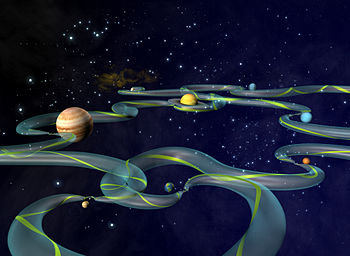
Back شبكة النقل بين الكواكب Arabic Interplanetary Transport Network Catalan Red de Transporte Interplanetario Spanish Réseau de transport interplanétaire French Межпланетная транспортная сеть Russian Interplanetariskt transportnätverk Swedish

The Interplanetary Transport Network (ITN)[1] is a collection of gravitationally determined pathways through the Solar System that require very little energy for an object to follow. The ITN makes particular use of Lagrange points as locations where trajectories through space can be redirected using little or no energy. These points have the peculiar property of allowing objects to orbit around them, despite lacking an object to orbit[further explanation needed]. While it would use little energy, transport along the network would take a long time.[2]
- ^ Ross, S. D. (2006). "The Interplanetary Transport Network" (PDF). American Scientist. 94 (3): 230–237. doi:10.1511/2006.59.994. Archived (PDF) from the original on 2013-10-20. Retrieved 2013-06-27.
- ^ "The Interplanetary Superhighway; Shane Ross; Virginia Tech". Archived from the original on 2019-06-15. Retrieved 2016-12-30.